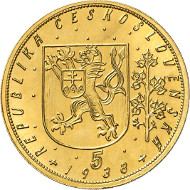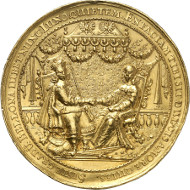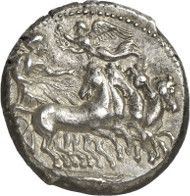09-03-2014 – 13-03-2014
Auction 245-248
Künker Spring Sale: A Week Full of Surprises
The spring auction of Künker / Osnabrück took five days. The four weighty catalogs contained many an interesting special collection. Hence, several hundreds of dealers and collectors came to the Hotel Steigenberger Remarque to witness the 6,129 lots on offer changing hands.
Auction sale 245 – Gold coins / German Empire coins since 1871 / Russian coins
The most remarkable result of day one was obtained by a 5 ducat piece from Czechoslovakia from 1938 of which just 56 specimens were produced.
569: Czechoslovakia. 5 ducats 1938, Kremnica. Fb. 5. Mintage only 56 specimens. About mint state. Estimate: 10,000 euros. Hammer price: 110,000 euros.
Its obverse shows the national coat of arms as well as a lime tree branch, on the reverse Saint Wenceslas with the lettering Hedej Zahynouti Nam i Budoucim (= Do not let us or our descendants perish). Its pre-sale estimate had been 10,000 euros, and it can be found for 30,000 euros in the latest World Coin Catalog written by Schön. That the two prices are totally out of date is evidenced by the hammer price: 110,000 euros!
The impressive results obtained by other gold coins, like the gold medal of Rudolf II on the seizure of the fortress of Gran in 1595, somewhat took the back seat. The good very fine piece rose from its estimate of 3,000 euros to 15,000 euros hammer price. Even higher was the price obtained by a Saxon 12 ducat piece from 1678 on the conferral of the Order of the Garter. The extremely fine rarity yielded 26,000 euros (estimate: 10,000 euros).
A collector was willing to pay 55,000 euros for the rare 20 mark piece from 1875 of Henry XXII of the Elder Line of Reuss. It therewith became the most expensive coin of the section German Empire.
1762: Russia. Paul I, 1796-1801. Gold medal of 10 ducats n. y. (1797), by C. Leberecht, on the coronation in Moscow. Diakov 243.7. Extremely rare. Extremely fine. Estimate: 40,000 euros. Hammer price: 85,000 euros.
The most expensive Russian coin was sold for 85,000 euros. It was an extremely fine gold medal of 10 ducats on the coronation of Paul I (1796-1801) in Moscow with a pre-sale estimate of 40,000 euros.
Auction sale 246 – Coins and medals from medieval to modern times
Catalog 246 comprising many special collections was next. In the afternoon of 11 March 2014 the special collection Malta was auctioned off that brought more than two times its estimate in the end. This is not the place to elaborate on every single spectacular result, so the three bestsellers will have to suffice:
2895: Malta / Sovereign Order. Ramon Perellos y Roccaful, 1697-1720. 2 zecchini n. d., Valetta. Fb. 20. Only two specimens available on the market. About very fine. Estimate: 10,000 euros. Hammer price: 24,000 euros.
Ramon Perellos y Roccaful (1697-1720), 2 zecchini, n. d., Valletta (about VF, only two specimens available on the market, 10,000 euros / 24,000 euros); Martin Garzes (1595-1601), 4 tari n. d., Valletta (EF, 2nd known specimen, 10,000 euros / 19,000 euros); Pierino del Ponte (1534-1535), zecchino n. d., Birgu or Fort St. Angelo (traces of mounting, VF, 6th known specimen, 3,000 euros / 16,000 euros).
An even higher total result with more remarkable hammer prices was achieved by the Chinese collection. The total results added up to three times the original estimate.
3164: China. Pei-Yang Province. 1 dollar year 22 (1896). Graded MS 62 by NGC. Dav. 186. Very rare. Extremely fine to mint state. Estimate: 15,000 euros. Hammer price: 140,000 euros.
The top seller was a dollar from Pei-Yang Province, graded MS 62 by NGC – which corresponds to the European grading extremely fine to mint state and that made the piece, rare as it is already, even rarer. The dollar from 1896 came with a rather modest estimate of 15,000 euros to rise to incredible 140,000 euros in the end!
Equally surprising at least was the result of a set of commemorative coins of The People’s Republic of China from 1990, ‘Dragon and Phoenix’. The material value had already been about 22,000 euros but the estimate of 30,000 was exceeded by far by the hammer price amounting to 80,000 euros which evidences that the Chinese people cherish their present coins just like their ancient ones. 38,000 euros still were obtained by a pattern of a dollar from Fengtien Province that was being produced by Schuler Company in 1897 and never issued (EF, 5,000 euros / 38,000 euros).
Comparatively modest were the results of the important Mansfeld Collection that was auctioned off on 12 March 2014. The most expensive coin was an extremely rare and extremely fine reichsthaler from 1710, minted in Eisleben on the death of John George III (3,000 euros / 11,000 euros).
Auction sale 247 – 500 Years of history and art as reflected in the medal. The Georg Baums Collection
Another highlight of the spring auction was the Baums Collection that was offered for sale on 13 March 2014. The collector had assembled a whole number of intriguing pieces that attracted wide interest. Whereas the pre-sale estimate had been 1.3 million euros, the hammer prices reached the total of 1.8 million euros.
5027: Baums Collection. Poland. Danzig. Gold medal of 16 ducats 1646 by J. Höhn, on the second wedding of Wladyslaw IV with Marie Louise Gonzaga. H.-Cz. 1859var. (silver there). From auction sale Helbing 38 (1913), 3022. Extremely rare. About extremely fine. Estimate: 20,000 euros. Hammer price: 42,000 euros.
Telling examples for the high hammer prices are the gorgeous, about extremely fine gold medal of the city of Danzig in the weight of 16 ducats from 1646 on the wedding of Wladyslaw IV with Marie Louise Gonzaga (20,000 euros / 42,000 euros) or a perfect Russian silver medal of Peter the Great on the Treaty of Nystad that probably was made in later times, during the 19th century, using the dies from 1721 (2,500 euros / 11,000 euros). As it was expected, the most expensive item of the Baums Collection was the magnificent Trinity Medal by Hans Reinhart (40,000 euros / 46,000 euros).
Collectors were given the opportunity to place their bid in the lower price regions as well. Many pieces ranged in the two- and three-figure regions, like for example a very interesting gilded bronze medal on philosopher and writer Jean-Jacques Rousseau. It came with an estimate of 75 euros but changed hands in the end for just 60 euros!
Auction sale 248 – Ancient coins
Friday was entirely devoted to ancient coins. Some very good results were to be witnessed with Greek coins.
7050: Greeks / Akragas. Tetradrachm, c. 411 B. C. Franke / Hirmer pl. 61. 178 (same dies). Very rare. Extremely fine. Estimate: 25,000 euros. Hammer price: 32,000 euros.
A very rare tetradrachm from Akragas with the two eagles gorging a hare had been estimated at 25,000 euros, to achieve a hammer price of 32,000 euros. Two dekadrachms from Syracuse were available for sale, the first – signed by Euainetos, preserved better than very fine – obtained 20,000 euros (12,500 euros), the second one – without signature – 16,000 euros (10,000 euros).
Roman aurei being in particularly high demand with collectors at present was evidenced by the auction sale’s second part. A good very fine aureus of Octavian from 43 B. C., formerly part of the collections Prowe and Huntington, rose from its estimate of 12,500 euros to 19,000 euros, a very fine aureus of Caligula with the head of Divus Augustus on its reverse rose from 10,000 euros to 26,000 euros and an extremely fine aureus of Vespasian from 15,000 euros to 34,000 euros.
7491: Roman Imperial Times / Domitia, wife of Domitian. Aureus, 82/3 or later. BMC -. Extremely rare. Extremely fine. Estimate: 30,000 euros. Hammer price: 65,000 euros.
The section’s most expensive coin was a likewise extremely fine aureus, dating to 82/3, showing the portrait of Domitia on its obverse and a peacock on its reverse (30,000 euros / 65,000 euros).
All results can be found on the website of Künker.
There you will also find a list of unsold lots available for sale at 80 % of their estimate.

















